一、安装TensorBoard
管理员身份运行Anaconda Prompt,进入自己的环境环境 conda activate y_pytorch,pip install tensorboard 进行下载,也可以通过conda install tensorboard进行下载。其实通俗点,pip相当于菜市场,conda相当于大型正规超市。
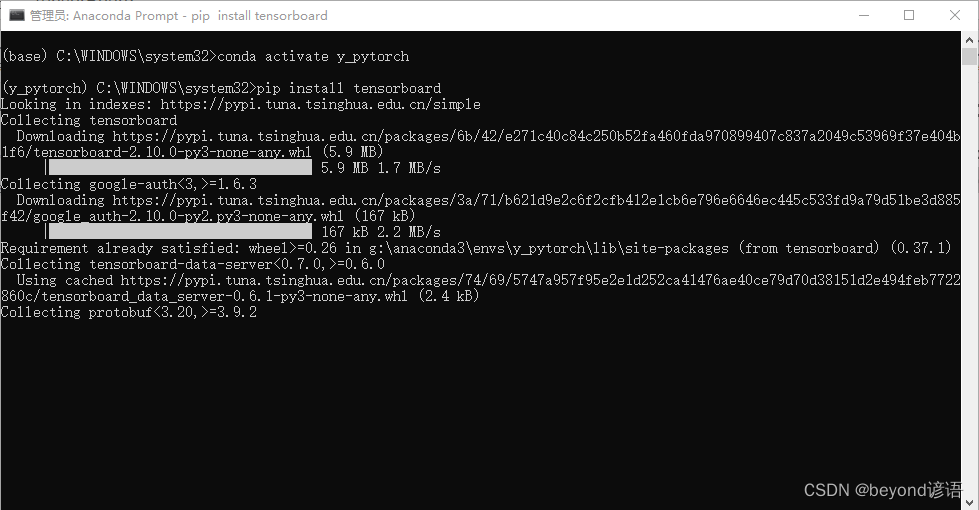
二、SummaryWriter类
所有编译均在PyChram下进行
from torch.utils.tensorboard import SummaryWriter
按着Ctrl,点击SummaryWriter,进入查看该类的使用说明文档
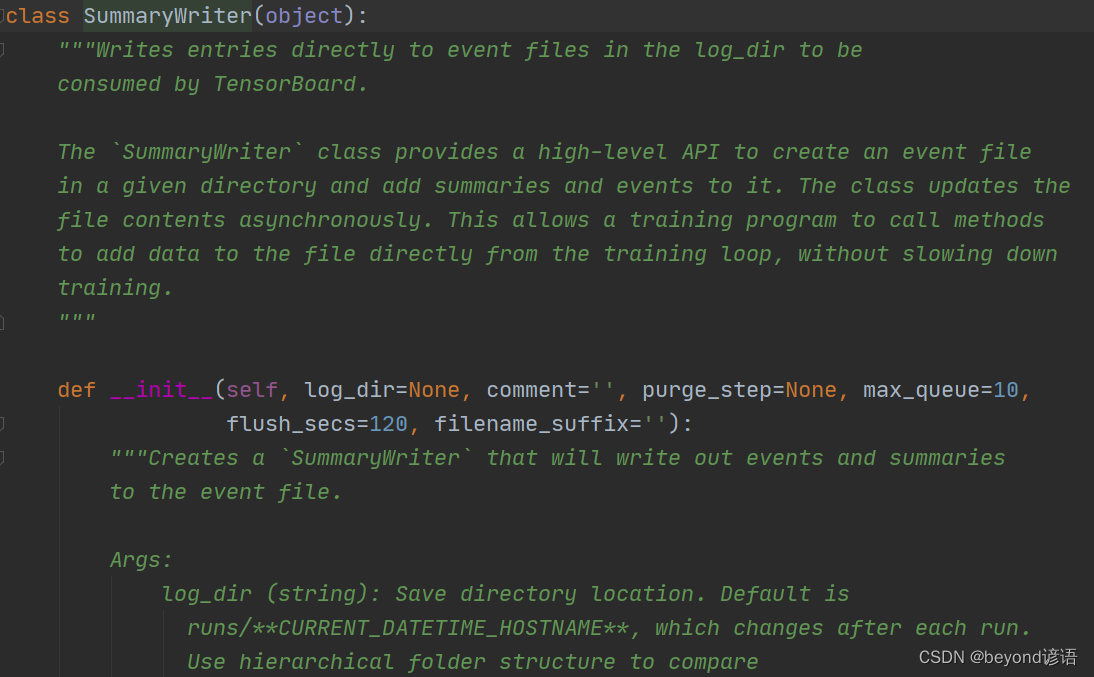
"""Writes entries directly to event files in the log_dir to be
consumed by TensorBoard.
将条目直接写入log_dir中的事件文件,供TensorBoard使用
The `SummaryWriter` class provides a high-level API to create an event file
in a given directory and add summaries and events to it. The class updates the
file contents asynchronously. This allows a training program to call methods
to add data to the file directly from the training loop, without slowing down
training.
"""
看不懂没关系,DL翻译一下就行了呗,大概就是,SummaryWriter类会生成一个文件,
这个文件会被TensorBoard所解析使用,也就是说可以通过TensorBoard进行可视化展示
#这个是SummaryWriter的初始化函数
def __init__(self, log_dir=None, comment='', purge_step=None, max_queue=10,
flush_secs=120, filename_suffix=''):
"""Creates a `SummaryWriter` that will write out events and summaries
to the event file.
Args:
log_dir (string): Save directory location. Default is
runs/**CURRENT_DATETIME_HOSTNAME**, which changes after each run.
Use hierarchical folder structure to compare
between runs easily. e.g. pass in 'runs/exp1', 'runs/exp2', etc.
for each new experiment to compare across them.
#保存的文件为log_dir所指定的位置,默认为runs/**CURRENT_DATETIME_HOSTNAME**这个位置
#同理,后面的参数可以进行翻译,然后进行学习即可
comment (string): Comment log_dir suffix appended to the default
``log_dir``. If ``log_dir`` is assigned, this argument has no effect.
purge_step (int):
When logging crashes at step :math:`T+X` and restarts at step :math:`T`,
any events whose global_step larger or equal to :math:`T` will be
purged and hidden from TensorBoard.
Note that crashed and resumed experiments should have the same ``log_dir``.
max_queue (int): Size of the queue for pending events and
summaries before one of the 'add' calls forces a flush to disk.
Default is ten items.
flush_secs (int): How often, in seconds, to flush the
pending events and summaries to disk. Default is every two minutes.
filename_suffix (string): Suffix added to all event filenames in
the log_dir directory. More details on filename construction in
tensorboard.summary.writer.event_file_writer.EventFileWriter.
Examples::
#如何使用,使用案例
from torch.utils.tensorboard import SummaryWriter
# create a summary writer with automatically generated folder name.
writer = SummaryWriter()
# folder location: runs/May04_22-14-54_s-MacBook-Pro.local/
#参数啥都不加,默认生成的文件会放入runs/May04_22-14-54_s-MacBook-Pro.local/位置
# create a summary writer using the specified folder name.
writer = SummaryWriter("my_experiment")
# folder location: my_experiment
#指定位置,生成的文件会放入指定位置
# create a summary writer with comment appended.
writer = SummaryWriter(comment="LR_0.1_BATCH_16")
# folder location: runs/May04_22-14-54_s-MacBook-Pro.localLR_0.1_BATCH_16/
"""
了解完SummaryWriter之后,开始为其创建对象
writer = SummaryWriter("y_log")#对应生成的文件会放入y_log文件夹下
三、add_scalar()方法
将标量数据添加到summary中
writer.add_scalar()#按住Ctrl,点击add_scalar方法,查看该方法的使用说明

"""Add scalar data to summary.
#将标量数据添加到summary中
Args:#参数
tag (string): Data identifier
#图标的title名称
scalar_value (float or string/blobname): Value to save
#要保存的数据值,一般用作y轴
global_step (int): Global step value to record
#记录全局的步长值,一般用作x轴
walltime (float): Optional override default walltime (time.time())
with seconds after epoch of event
new_style (boolean): Whether to use new style (tensor field) or old
style (simple_value field). New style could lead to faster data loading.
Examples::
from torch.utils.tensorboard import SummaryWriter
writer = SummaryWriter()
x = range(100)
for i in x:
writer.add_scalar('y=2x', i * 2, i)
writer.close()
Expected result:
.. image:: _static/img/tensorboard/add_scalar.png
:scale: 50 %
"""
绘制一个y=3*x的图,通过tensorboard进行展示
from torch.utils.tensorboard import SummaryWriter
writer = SummaryWriter("y_log")#文件所存放的位置在y_log文件夹下
for i in range(100):
writer.add_scalar("y=3*x",3*i,i)#图标的title为y=3*x,y轴为3*i,x轴为i
#要注意的是title若一样,则会发生拟合现象,会出错。一般不同图像要对应不同的title,一个title会对应一张图。
writer.close()
运行完之后,发现多了个文件夹,里面存放的就是tensorboard的一些事件文件

在Terminal下运行tensorboard --logdir=y_log --port=7870,logdir为打开事件文件的路径,port为指定端口打开;
通过指定端口7870进行打开tensorboard,若不设置port参数,默认通过6006端口进行打开。

点击该链接或者复制链接到浏览器打开即可
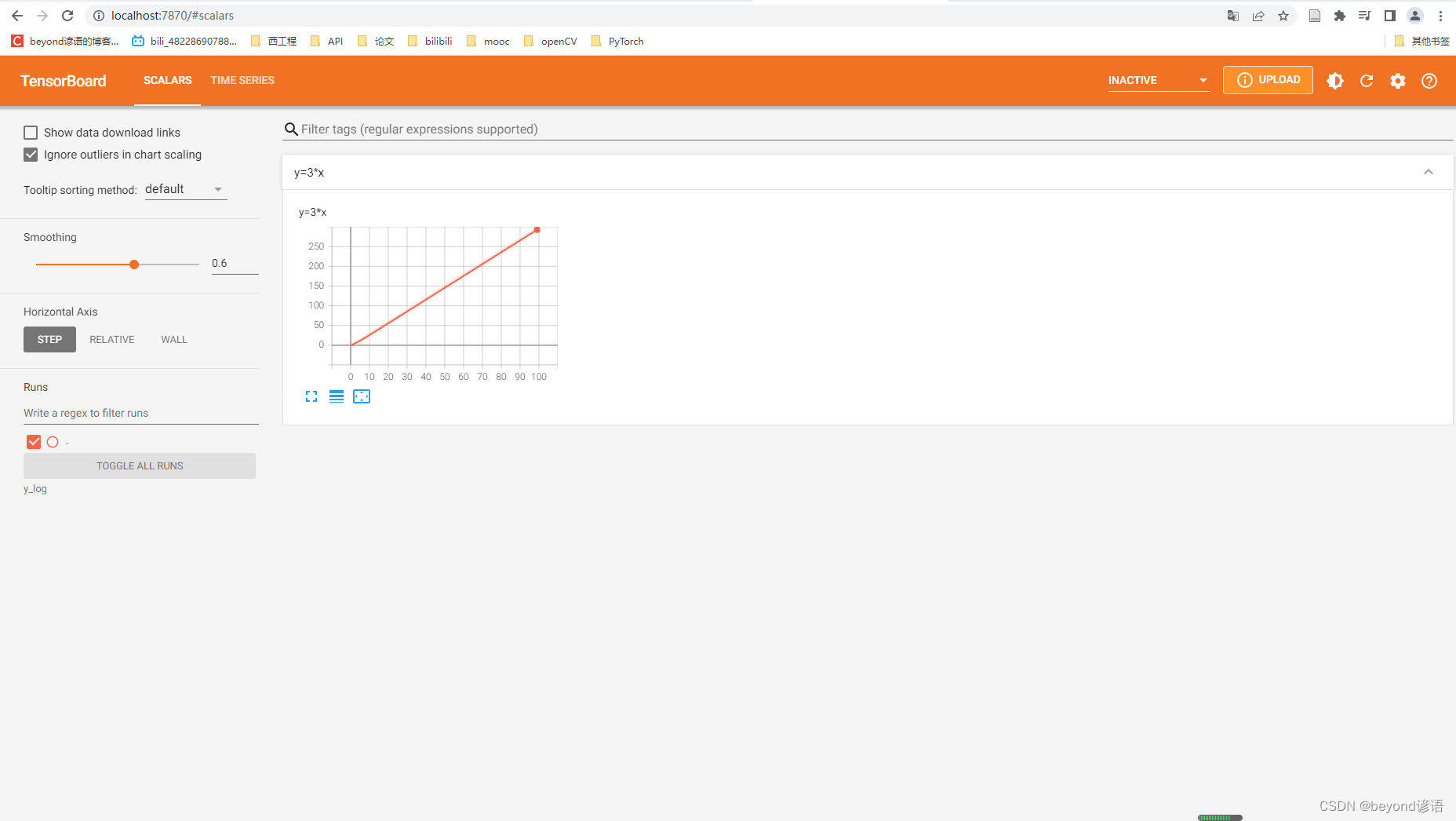
四、add_image()方法
将图像数据添加到summary中
同样的道理,进行查看该方法的使用说明
writer.add_image()#按住Ctrl,点击aadd_image方法,查看该方法的使用说明
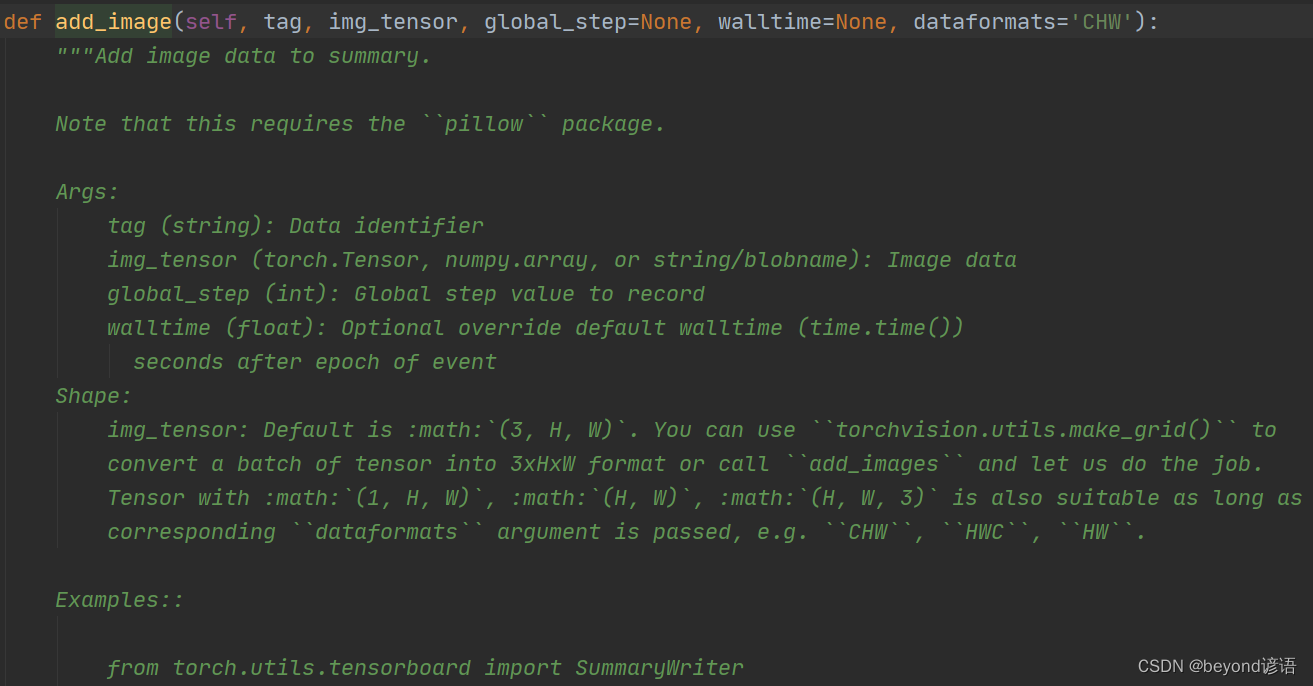
"""Add image data to summary.
#将图像数据添加到summary中
Note that this requires the ``pillow`` package.
Args:#参数
tag (string): Data identifier
#对数据的定义,也就是在tensorboard中显示的时候title是啥
img_tensor (torch.Tensor, numpy.array, or string/blobname): Image data
#这里对图像的要求必须是这几类,需要将图片类型进行转换
global_step (int): Global step value to record
#记录的全局步长,也就是第几张图片
walltime (float): Optional override default walltime (time.time())
seconds after epoch of event
Shape:
img_tensor: Default is :math:`(3, H, W)`. You can use ``torchvision.utils.make_grid()`` to
convert a batch of tensor into 3xHxW format or call ``add_images`` and let us do the job.
Tensor with :math:`(1, H, W)`, :math:`(H, W)`, :math:`(H, W, 3)` is also suitable as long as
corresponding ``dataformats`` argument is passed, e.g. ``CHW``, ``HWC``, ``HW``.
##图片的类型应该为(3, H, W),若不一样则可以通过dataformats参数进行设置
Examples::
from torch.utils.tensorboard import SummaryWriter
import numpy as np
img = np.zeros((3, 100, 100))
img[0] = np.arange(0, 10000).reshape(100, 100) / 10000
img[1] = 1 - np.arange(0, 10000).reshape(100, 100) / 10000
img_HWC = np.zeros((100, 100, 3))
img_HWC[:, :, 0] = np.arange(0, 10000).reshape(100, 100) / 10000
img_HWC[:, :, 1] = 1 - np.arange(0, 10000).reshape(100, 100) / 10000
writer = SummaryWriter()
writer.add_image('my_image', img, 0)
# If you have non-default dimension setting, set the dataformats argument.
writer.add_image('my_image_HWC', img_HWC, 0, dataformats='HWC')
writer.close()
Expected result:
.. image:: _static/img/tensorboard/add_image.png
:scale: 50 %
"""
添加图片到tensorboard中
from torch.utils.tensorboard import SummaryWriter
import cv2 as cv
import numpy as np
writer = SummaryWriter("y_log")
img_path = "G:/PyCharm/workspace/learning_pytorch/dataset/a/1.jpg"
img = cv.imread(img_path)
img_array = np.array(img)
print(type(img_array))#<class 'numpy.ndarray'> 满足该方法img_tensor类型
print(img_array.shape)#(499, 381, 3) 这里看到是(H, W, 3),并不是人家指定的(3, H, W),需要设置dataformats来声明该数据规格为HWC
writer.add_image("beyond",img_array,0,dataformats="HWC")#将来在tensorbord显示的title为beyond
writer.close()
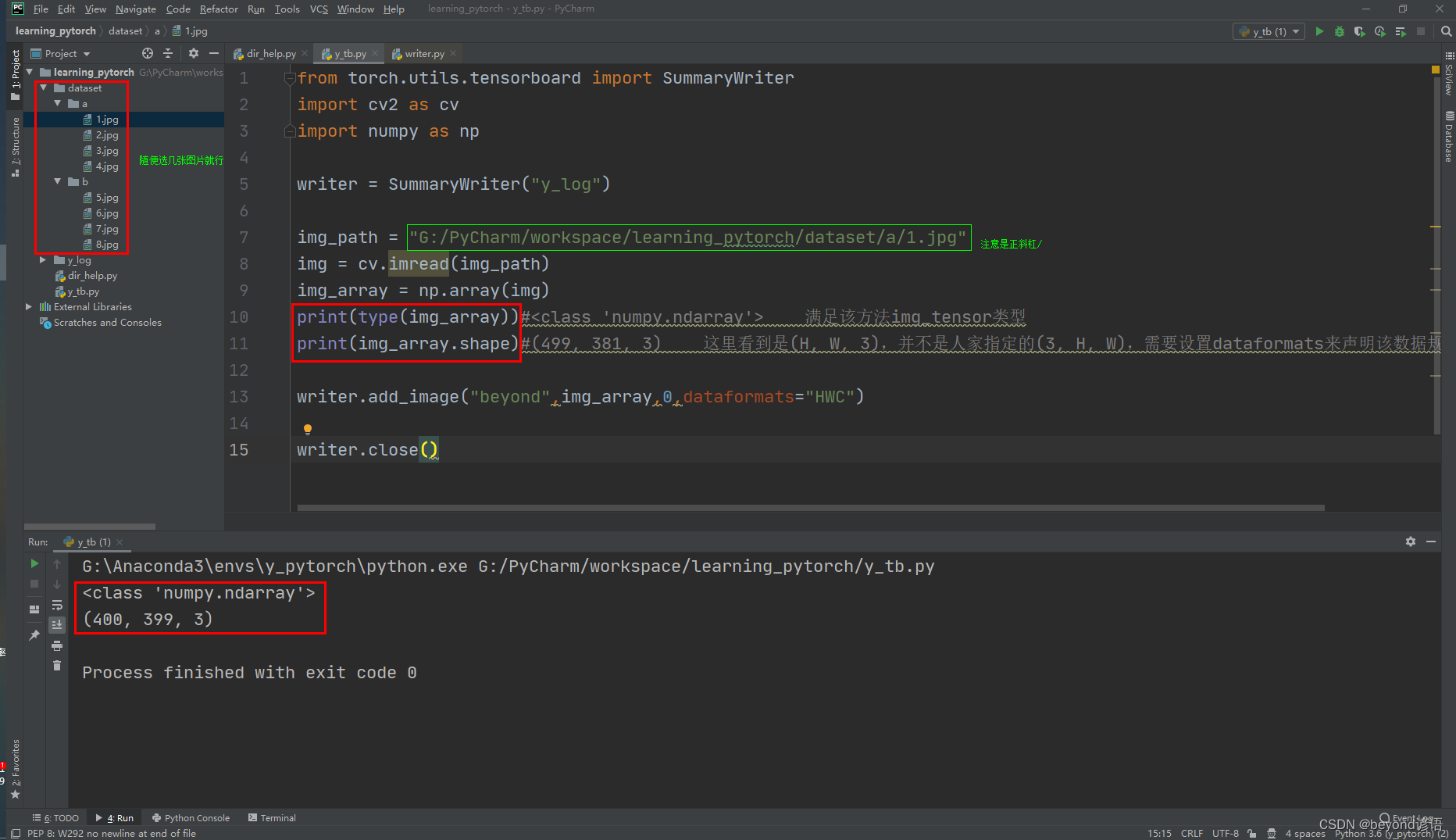
在Terminal下运行tensorboard --logdir=y_log --port=7870,logdir为打开事件文件的路径,port为指定端口打开;
通过指定端口7870进行打开tensorboard,若不设置port参数,默认通过6006端口进行打开。

点击该链接或者复制链接到浏览器打开即可
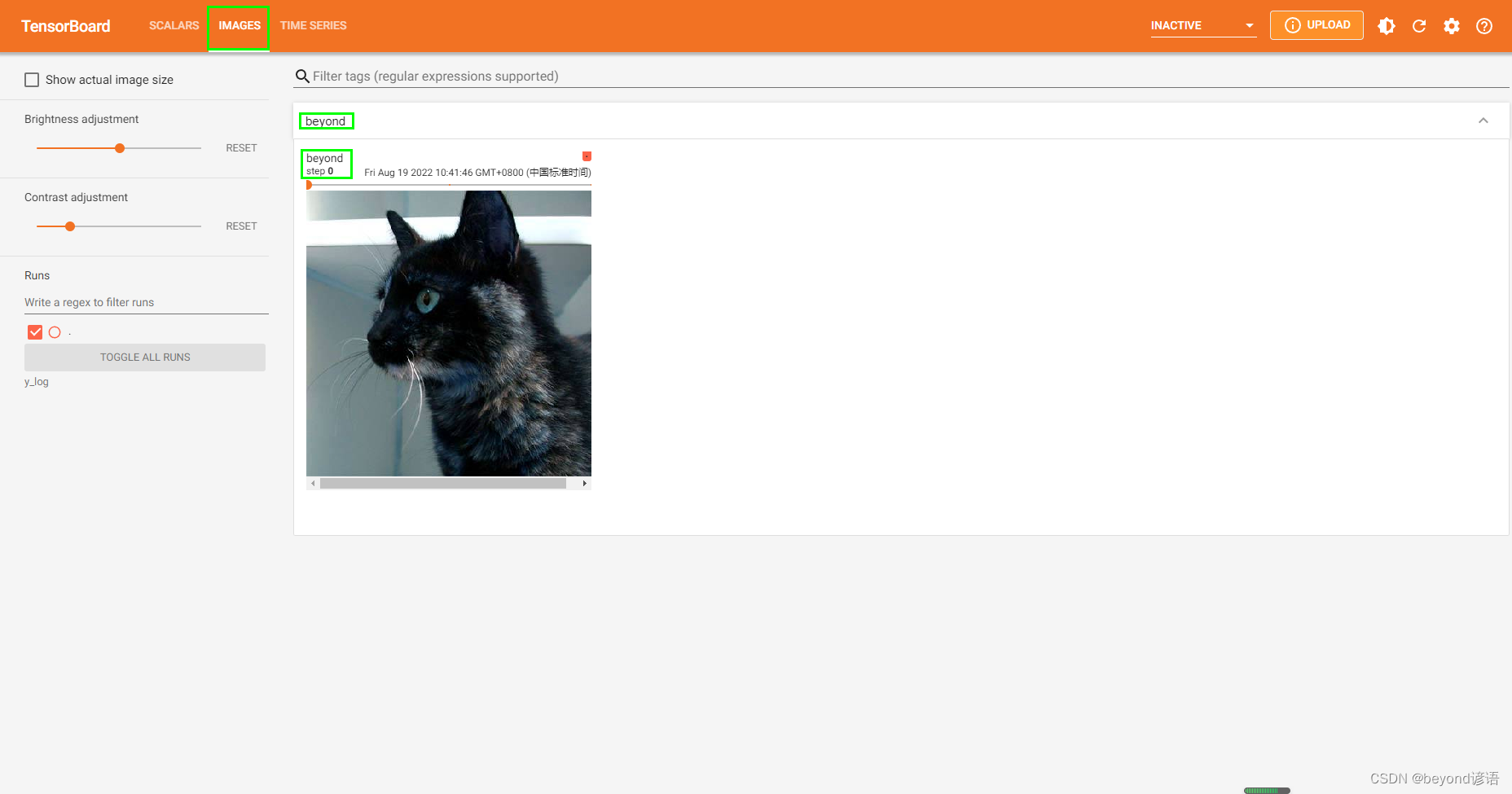





















 2万+
2万+











 被折叠的 条评论
为什么被折叠?
被折叠的 条评论
为什么被折叠?








